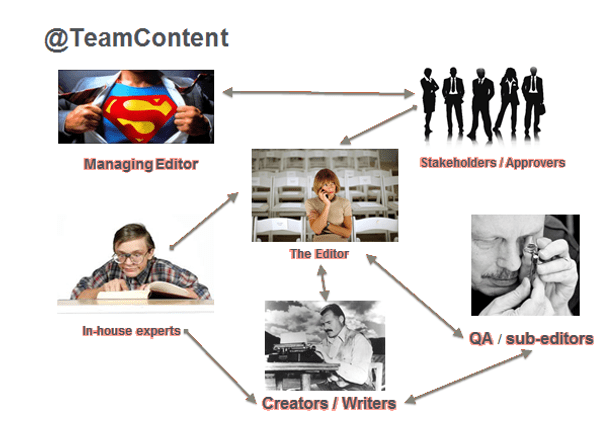Day 3 in our 5 days to Successful Content Marketing series

In previous days in our series we have defined a vision and strategy for Content Marketing. Now, today’s the day to start thinking about who’s actually going to put all of this together. You’ll need to work out who does what in your content team, and how much time and effort you can realistically muster.
At its simplest, your content team needs to look something like this:

All of the above roles could be resourced in different ways, depending on the scale and ambition of your operation. In some cases, several roles may be filled by one person wearing several hats; in other cases, one role may be taken by a whole team or an outsourced agency. Here are the key players:
- The Editor sits at the heart of the operation. They decide what you talk about and when, commission work from the creators (writers/designers/video producers etc), and also decide what to leave out. They’re basically the content plan in walking, talking human form.
- The Creators get stuff done to briefs supplied by the editor. (Remember that it’s vital to create a simple briefing form.)
- The QA/Sub-Editor checks content for style, consistency, digital best practice, typos and so forth.
- Your in-house experts provide the raw material for your content. They may not be client-facing, and they may not know how to write in short, snappy bullets. However, they are the guardians of your in-house expertise. Part of the Editor’s job is to cultivate relationships with the experts and find ways to gather raw material from them that can be turned into usable, shareable, search-friendly content.
- The Managing Editor is a senior sponsor for your operation. They have enough clout to argue for the budget and resource that will enable you to maximise the returns on your content.
- Often demonised, your stakeholders are the people who sign things off – or not – including legal, compliance, brand, SEO and more. No content marketing operation can succeed without taking their input into account. The key to stakeholder management is to educate them up front about what you’re trying to achieve and to make them part of the content creation journey from the outset, rather than see them as adversaries who come in at the end and spoil the content party. Stakeholders are people too, and they have an important job to do.
Work out who does what, how much time they’ll have available for content marketing, and decide how much content you can realistically produce per week or month.
Always start small and always underestimate what you can do. If you think 1 blog post per week, a daily tweet and a monthly white paper is about as much as you’ll be able to produce initially, that’s fine. Commit to that, make it happen and keep it going. Once you get some traction from your content, you can build the business case for more resource and more dedicated time.
Output: A simple diagram of your team structure, identifying key roles and the people who’ll be carrying them out. A brief summary of resource and minimum content output. A simple briefing form.
Case study: Indium Corp
Indium Corp manufactures soldering components. The company now runs a massive 73 different blogs, all based on targeted keyword phrases related to their industry, with the goal of creating contacts that convert.

According to content marketing guru Rebecca Lieb, the strategy resulted in customer contacts increasing by 600% in a single quarter. All of the blogs are written by Indium engineers, who are passionate about what they do and have the necessary expertise to talk knowledgeably to prospects.
[Editor's note: For more on structuring teams to manage multichannel marketing, see our Structuring a Digital Team template for Expert members.]
Image/Copyright:@PA Images

Thanks to Dan Brotzel for sharing his thoughts and opinions in this blog post. Dan is the Content Director at
stickycontent, part of the Press Association. He is also Econsultancy's trainer in Content Marketing and Editorial Planning. You can connect with Dan on
LinkedIn or follow stickycontent on
Twitter






 Thanks to Dan Brotzel for sharing his thoughts and opinions in this blog post. Dan is the Content Director at
Thanks to Dan Brotzel for sharing his thoughts and opinions in this blog post. Dan is the Content Director at 


